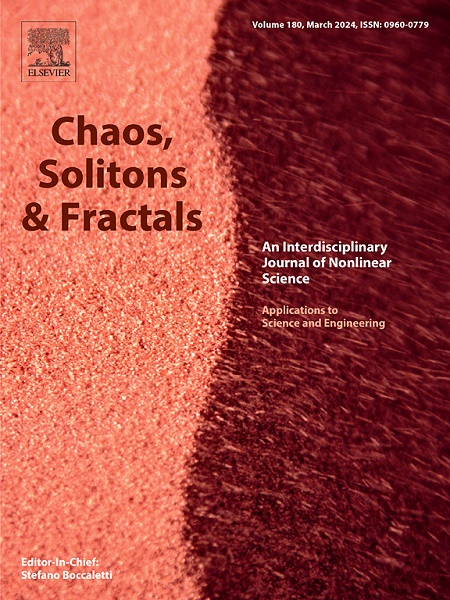高阶加权网络中带有信息疲劳和行为反应的信息-疾病耦合动力学
IF 5.6
1区 数学
Q1 MATHEMATICS, INTERDISCIPLINARY APPLICATIONS
引用次数: 0
摘要
在信息-疾病耦合传播的协同进化中,信息传播可以有效抑制疫情的爆发。然而,过度的信息传播会导致信息疲劳,降低个体对信息的接受度。个体之间的直接互动(两两关系)和不同群体环境中的高阶互动(如三人或三人以上群体的信息传播影响)在强度和传播效率上表现出显著差异。此外,个体对流行病的行为反应往往推动网络结构和传播系统的共同进化。针对传统模型对个体相互作用异质性与行为反应之间动态相关性描述不足的问题,提出了一种新的信息-疾病耦合模型(UAF-SIS)。在信息层,我们构建了基于2-单纯形结构的加权高阶网络,系统地分析了正相关、负相关和随机相关三种加权机制对耦合传输动力学的影响。在疾病层,我们引入了一个具有吸引力的活动驱动网络模型,并通过整合个体对疾病的主动隔离和社会回避等行为反应,建立了网络结构和传播系统的协同进化框架。采用微观马尔可夫链法(MMCA)推导了疫情爆发阈值,并通过蒙特卡罗(MC)模拟对理论结果进行了验证。实验结果表明,信息疲劳效应强调了公共管理中控制社交媒体信息传播频率的必要性:过度高频传播显著降低了个体对信息的接受度。不同加权机制对耦合传播过程的影响差异较大:正相关加权增强了信息抑制疾病传播的作用,而负相关加权可能放大疾病流行的风险。个体的行为反应和疾病层的时变特征共同驱动着网络结构的演化,显著影响着传播动力学的轨迹。我们的研究不仅为公共卫生管理提供了实践建议,而且为理解信息-疾病耦合传播的复杂机制奠定了理论基础。本文章由计算机程序翻译,如有差异,请以英文原文为准。
Information-disease coupling dynamics with message fatigue and behavioral responses in higher-order weighted networks
In the coevolution of information-disease coupled transmission, information dissemination can effectively suppress epidemic outbreaks. However, excessive information spread can lead to message fatigue and reduces individuals’ acceptance of the information. Direct interactions between individuals (pairwise relationships) and higher-order interactions within various group environments (such as the effects of information dissemination in groups of three or more) exhibit significant differences in intensity and transmission efficiency. Additionally, individuals’ behavioral responses to epidemics often drive the coevolution of network structures and spreading systems. Aiming to address the inadequate characterization of the dynamic correlation between individual interaction heterogeneity and behavioral responses in traditional models, we propose a novel information-disease coupled model (UAF-SIS). At the information layer, we construct a weighted higher-order network based on 2-simplex structures, systematically analyzing the impacts of three weighting mechanisms – positive correlation, negative correlation, and random correlation – on the dynamics of coupled transmission. At the disease layer, we introduce an activity-driven networks with attractiveness model and develop a coevolution framework for network structures and transmission systems by integrating individuals’ behavioral responses to diseases, such as proactive isolation and social avoidance. The epidemic outbreak threshold is derived using the microscopic Markov chain method (MMCA), and theoretical results are validated through Monte Carlo (MC) simulations. Experimental findings demonstrate that the message fatigue effect underscores the necessity of controlling the dissemination frequency of social media information in public management: excessively high-frequency propagation significantly diminishes individuals’ acceptance of information. The impacts of different weighting mechanisms on the coupled transmission process vary considerably: positive correlation weighting enhances the effect of information in suppressing disease transmission, while negative correlation weighting may amplify the risks of disease prevalence. Furthermore, individuals’ behavioral responses and the time-varying characteristics of the disease layer jointly drive the evolution of network structure, significantly influencing the trajectory of transmission dynamics. Our research not only provides practical recommendations for public health management but also establishes a theoretical foundation for understanding the complex mechanisms of information-disease coupled transmission.
求助全文
通过发布文献求助,成功后即可免费获取论文全文。
去求助
来源期刊

Chaos Solitons & Fractals
物理-数学跨学科应用
CiteScore
13.20
自引率
10.30%
发文量
1087
审稿时长
9 months
期刊介绍:
Chaos, Solitons & Fractals strives to establish itself as a premier journal in the interdisciplinary realm of Nonlinear Science, Non-equilibrium, and Complex Phenomena. It welcomes submissions covering a broad spectrum of topics within this field, including dynamics, non-equilibrium processes in physics, chemistry, and geophysics, complex matter and networks, mathematical models, computational biology, applications to quantum and mesoscopic phenomena, fluctuations and random processes, self-organization, and social phenomena.
 求助内容:
求助内容: 应助结果提醒方式:
应助结果提醒方式:


